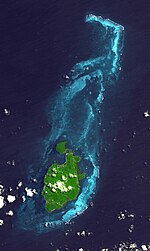The Seaflower was a sailing ship (likely a fluyt) built in England. Regarded as sister ship to the Mayflower, the Seaflower also transported settlers to the New World, specifically to Jamestown, Virginia, colony in 1621.[1][2] It was most notable for helping settle Puritans on the Caribbean Providence Island colony in 1631.[3][4] The Colombian Marine Protected Area and Biosphere Reserve surrounding the islands is named after the ship.[5][6][additional citation(s) needed]

First ship
editSeaflower (or Seaflour[7]) was 140 tons, and frequented Bermuda (then known as the Somers Isles). Some time before 20 March [O.S. 30 March] 1622, the ship was accidentally sunk by a gunpowder explosion in the cabin.[8] Apparently the explosion was caused by the captain's son mishandling lighted tobacco in the gunroom.[9][additional citation(s) needed] It was carrying supplies for a relief mission to Virginia.[10][additional citation(s) needed]
Second ship
editRecords indicate that the a second ship was named Sea Flower [sic]. It is unknown whether the first or second ship were distinctly different in design or construction. This Sea Flower is documented to have been captained by Ralph Hamor with 120 settlers who arrived in Virginia colony, February, 1622.[11] This ship also sailed back to England (arriving in June, 1622) with news of the Indian attacks on Englishmen that began in March.[12]
In 1629, Privateer Captain Daniel Elfrith (aboard the Robert) scouted the archipelago of "Santa Calatina" for riches and as a staging point for Spanish ship plundering.[13] The Earl of Warwick was looking for a new location to build a colony, yielding the setup of Providence Island Company.[14] In c. February 1631, 100 men and boys (mostly Puritans recruited from Essex, England) boarded the Seaflower, sailing from Deptford to Providence Island.[15] Ninety passengers settled the island in c. May 1631,[16] intending to load the ship with exotic plants and produce for profit in London.[17]
Seaflower returned to London, England, in March, 1632. It was attacked-at-sea by Spanish during the return voyage, with Captain John Tanner and crew narrowly escaping. The ship's cargo was only a small batch of poor quality tobacco.[18] Later, the Seaflower returned to Providence Island and was loaded again, this time with 1 tonne (1,000 kg) of "mechoacan potatoes" (Ipomoea purga), used as a medicine.[19]
In autumn 1676, the Seaflower was still in use as a transport for slaves from Africa to the Caribbean.[20] During and after King Phillip's War, the Seaflower was used to transport Native Americans as slaves to Bermuda and other Caribbean colonies.[21][22]
In 1696, notorious pirates Henry Every and Joseph Faro most likely[note 1] used the ship during their time in and around Rhode Island.[24][25]
See also
editNotes
editFootnotes
edit- ^ It is debatable that the single-sail sloop, the Sea Flower [sic] used by Henry Every was a different ship than the multi-sail Seaflower.[23]
References
edit- ^ Feiling, Tom. The Island that Disappeared: The Lost History of the Mayflower's Sister Ship and Its Rival Puritan Colony. p. 32. ISBN 978-1-61219-708-1.
- ^ Stevens, Anne. "Seaflower 1621". Packrat Productions. Retrieved 23 April 2024.
- ^ Coldham, Peter Wilson (1987). The Complete Book of Emigrants: 1607–1660. Genealogical Publishing Com. ISBN 978-0-8063-1192-0. Retrieved 9 September 2012.
- ^ "The island that disappeared: the lost history of the mayflower's sister ship and its rival puritan colony [us edition]". www.tomfeiling.com.
- ^ "Providencia: An island with a 'sea of seven colours'". www.bbc.com.
- ^ "The Protocol on Specially Protected Areas and Wildlife in the Wider Caribbean (SPAW): Seaflower Marine Protected Area" (PDF). October 23, 2012. Archived (PDF) from the original on March 11, 2023. Retrieved April 23, 2024.
- ^ Kolb, Avery E. (October 1980). "Early Passengers to Virginia: When Did They Really Arrive?". The Virginia Magazine of History and Biography. 88 (3): 401–414. Retrieved July 22, 2024.
- ^ Lefroy, Sir John Henry (1877). Memorials of the discovery and early settlement of the Bermudas or Somers Islands, 1515-1685. pp. XXXV, 119, 264, 287, 326.
- ^ "A Brief History of Jamestown, Virginia". web.archive.org. October 17, 2007.
- ^ Stanard, Mary Newton (1928). Story of Virginia's First Century. Philadelphia, PA: Lippincott. pp. 179-181.
- ^ Boddie, John Bennett (April 1933). "Edward Bennett of London and Virginia". The William and Mary College Quarterly Historical Magazine. 13 (2): 117–130. doi:10.2307/1921133. Retrieved July 24, 2024.
- ^ Vaughan, Alden T. (January 1978). ""Expulsion of the Salvages": English Policy and the Virginia Massacre of 1622". The William and Mary Quarterly. 35 (1): 57–84. doi:10.2307/1922571. Retrieved July 23, 2024.
- ^ Feiling, Tom. The Island that Disappeared: The Lost History of the Mayflower's Sister Ship and Its Rival Puritan Colony. p. 3. ISBN 978-1-61219-708-1.
- ^ Feiling, Tom. The Island that Disappeared: The Lost History of the Mayflower's Sister Ship and Its Rival Puritan Colony. p. 9. ISBN 978-1-61219-708-1.
- ^ Feiling, Tom. The Island that Disappeared: The Lost History of the Mayflower's Sister Ship and Its Rival Puritan Colony. p. 30-33. ISBN 978-1-61219-708-1.
- ^ Hamshere, Cyril (1972). The British in the Caribbean. pp. 41–44. ISBN 9780674082359.
- ^ Feiling, Tom. The Island that Disappeared: The Lost History of the Mayflower's Sister Ship and Its Rival Puritan Colony. p. 39. ISBN 978-1-61219-708-1.
- ^ Feiling, Tom. The Island that Disappeared: The Lost History of the Mayflower's Sister Ship and Its Rival Puritan Colony. p. 43. ISBN 978-1-61219-708-1.
- ^ Feiling, Tom. The Island that Disappeared: The Lost History of the Mayflower's Sister Ship and Its Rival Puritan Colony. p. 48. ISBN 978-1-61219-708-1.
- ^ Newell, 2015, p. 148. https://mayflowermavericks.wordpress.com/2017/03/03/news2/
- ^ Philbrick, Nathaniel (2006). Mayflower: A Story of Courage, Community, and War. Viking. p. 364. ISBN 9780670037605.
- ^ "Mayflower to Seaflower". March 3, 2017.
- ^ Rogoziński 2000, p. 90
- ^ "Coins found in New England help solve mystery of murderous 1600s pirate: "One of the greatest crimes of the 17th century" - CBS News". www.cbsnews.com. December 8, 2022.
- ^ "Ancient coins may solve mystery of murderous 1600s pirate | National News | wacotrib.com". web.archive.org. April 1, 2021.